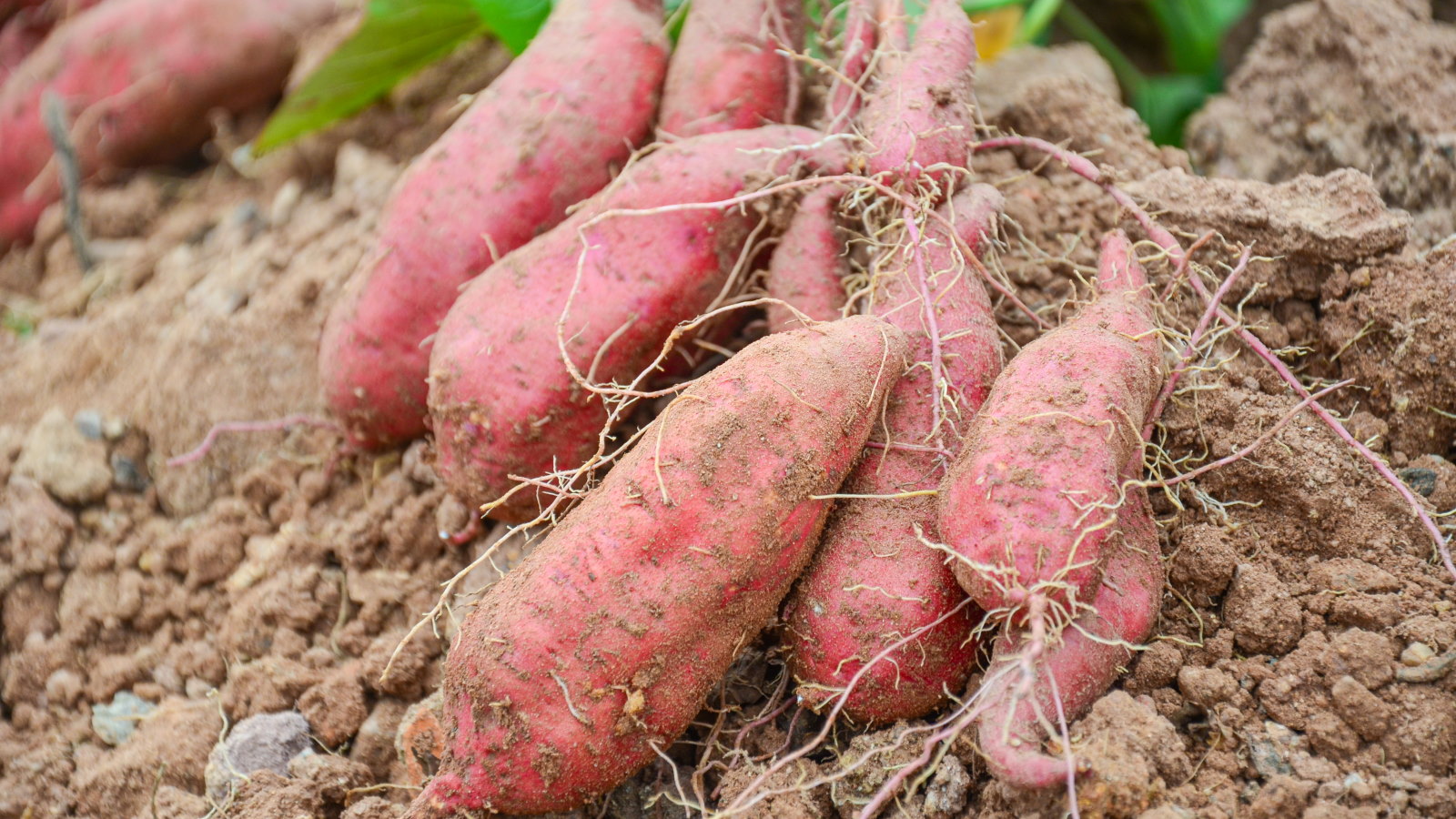
Sweet potatoes are a popular crop to grow in home vegetable gardens, and the delicious, versatile tubers can be roasted, mashed, chipped, and more, once lifted. If you are worried you don’t have the space to grow them, did you know you can grow sweet potatoes in a container?
The heat-loving vegetable needs a large container to grow in and regular watering and feeding throughout the growing season to get a good yield from your plants. Whether you choose a pot, planter, bucket, or grow bag, the plants can thrive given the right care and attention.
If you are thinking about how to grow sweet potatoes in your vegetable garden this year, consider cultivating them in pots. There are real advantages to growing sweet potatoes in a container.
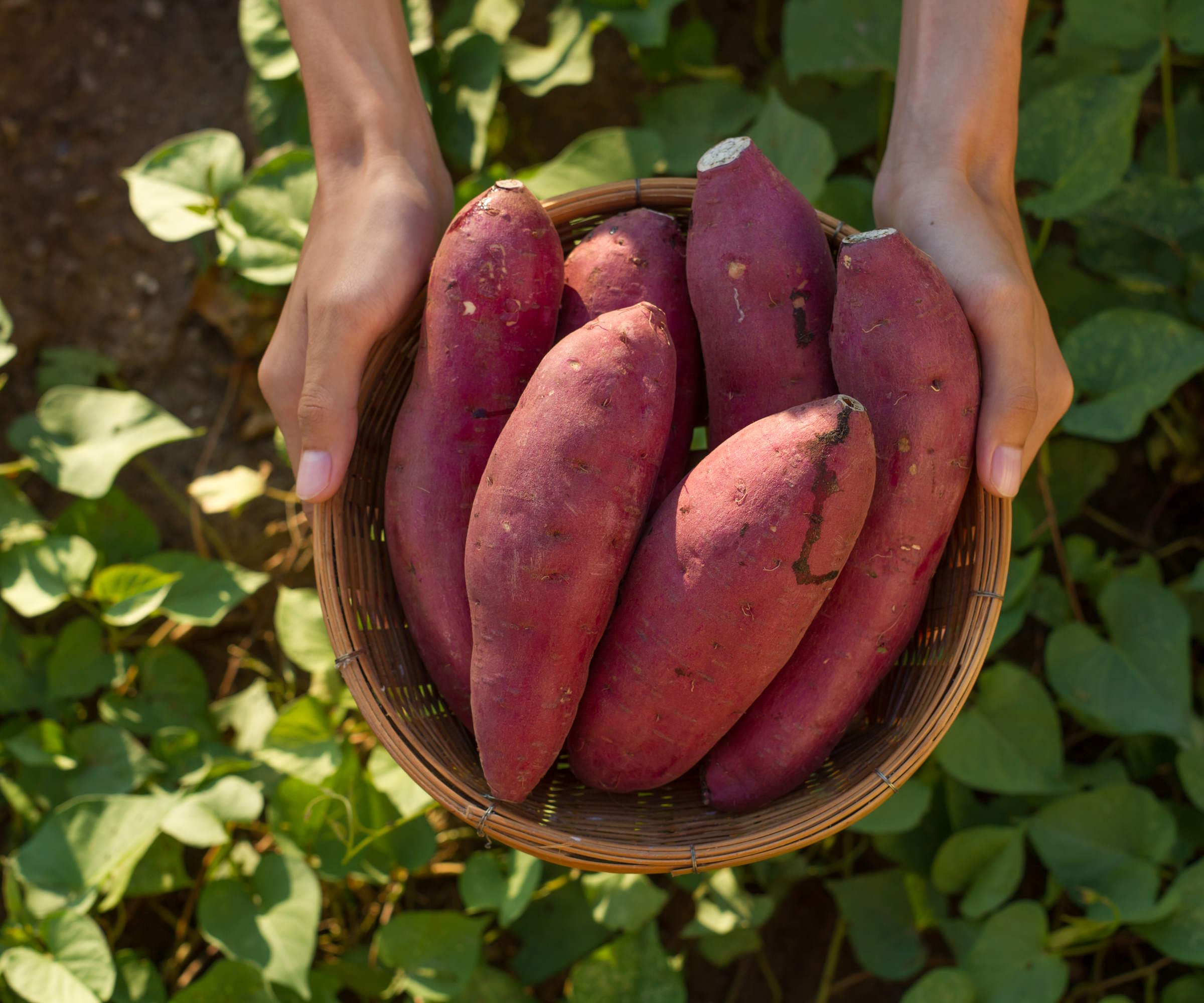
Advantages of sowing sweet potatoes in pots
Growing sweet potatoes in pots as part of a vegetable container garden, or in raised garden beds, is a great way of getting a crop in a small space. As sweet potatoes can be a sprawling crop, growing them in containers opens up the potential if you only have a small vegetable garden or are short on space and grow vegetables on a patio, deck, or balcony.
On top of being a space-saving way to grow them, Christy Wilhelmi, founder of Gardenerd, hails planting sweet potatoes in pots as a fantastic solution for growers in warmer US hardiness zones.
‘I've grown them in pots and recommend it for gardeners who don't want to dedicate a permanent bed to sweet potatoes,’ says Christy. ‘Here in Southern California, they come back year after year as a perennial for up to eight years, so growing in containers is a perfect solution for folks who don't want to give up that space for that long.’
7 steps to successfully grow sweet potatoes in a container

Growing sweet potatoes in a container can be a straightforward way to get a fantastic harvest of tubers in small spaces. To help you get the best yield possible, we look in-depth at some key areas to get the conditions right and care for plants correctly.
1. Prepare the tubers
Sweet potatoes are grown from slips, rather than from seed, and you can get both slips and young plants from nurseries, garden centers, or online - depending on how you want to plant the vegetable. The slips are side shoots that grow out of sweet potatoes and these want to be potted up quickly upon receiving them. Alternatively, you can grow your own slips by suspending a sweet potato tuber in water using toothpicks.
While you can grow a sweet potato from an old store-bought one, Christy Wilhelmi warns against the practise. ‘It's best to grow them from slips, these are available from online seed companies. It is a better way to start your crop because slips will be disease-free, whereas sweet potatoes from the grocery store may harbor pathogens.’
Slips should be planted into well-draining potting soil once the shoots are 2-3 inches long and kept somewhere warm to grow. The young plants can be planted in their final container once the risk of frost has passed.
Discover the range of sweet potatoes available at Burpee to grow in pots in your backyard.
2. Pick a large container
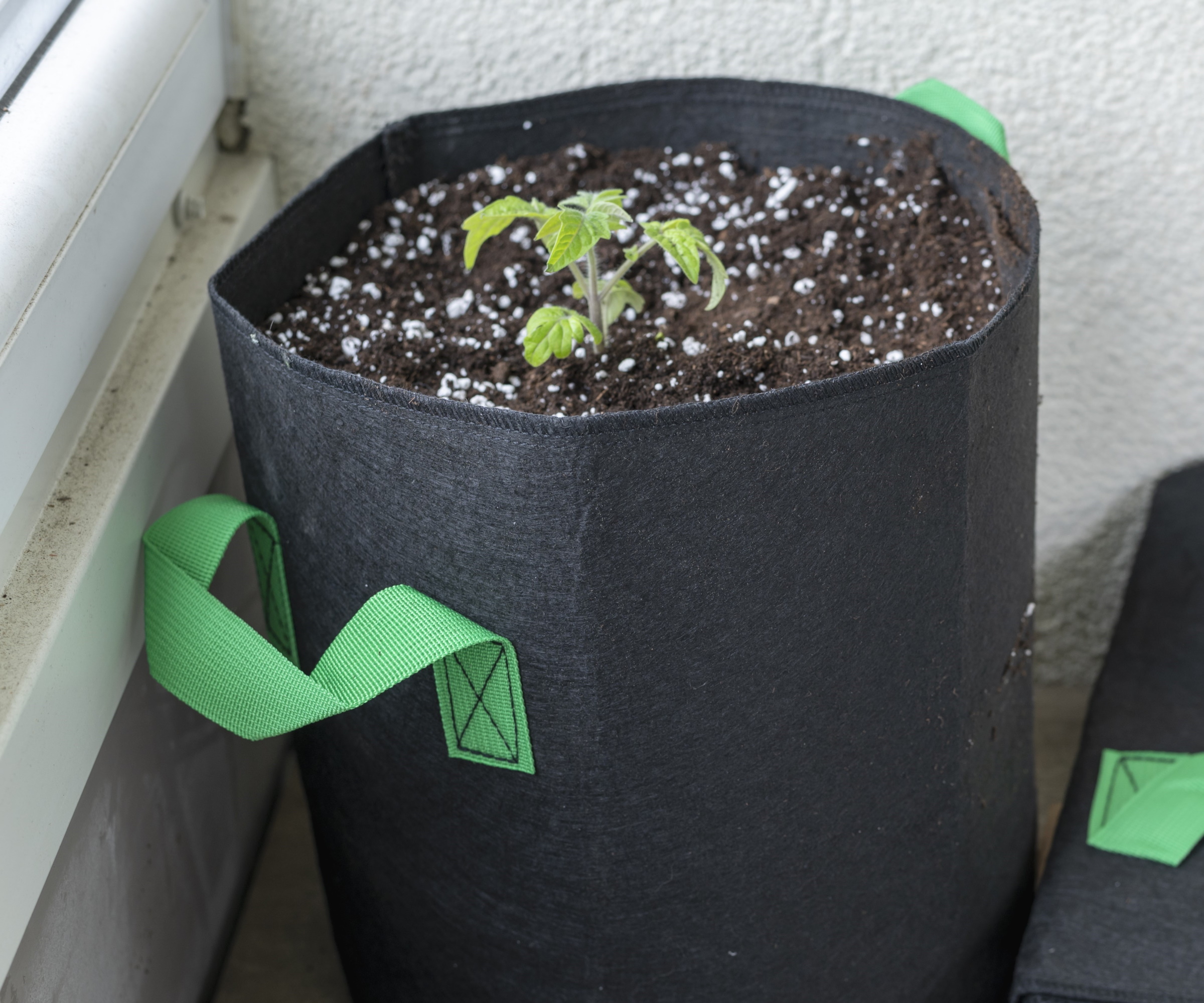
Sweet potatoes are large plants and you want a big container to get a good yield of tubers come harvesting time. There are various options for the type of container, but it needs to be a minimum of 20 inches in diameter and 15 inches deep and have holes in the bottom for drainage. A 10-gallon container is good for holding one plant, while two or three sweet potato plants can be planted in a 20-gallon container.
The pots can be plastic, terracotta, stone, or glazed ceramic, while Jon Traunfeld, director of the University of Maryland Extension Home & Garden Information Center, highlights grow bags as a good choice for growing sweet potatoes, saying: ‘They are lightweight, inexpensive, and they air prune roots’
Just as you can grow potatoes in a bag or grow potatoes in a bucket, there is a wide range of options when it comes to containers for sweet potatoes. Think big, though, as a larger pot will reward you with the biggest harvest.
3. Fill the pot with the right soil
Fill your chosen container with a fertile and well-draining potting mix. Sweet potatoes are hungry crops, so mix some organic matter, such as compost or well-rotted manure, into the mix. Alternatively, adding a handful of slow-release balanced fertilizer into the soil can help boost fertility. The soil wants to be filled to around an inch or two beneath the container’s rim and the sweet potato slip planted in the soil.
Do not reuse old potting soil and resist the temptation to use old garden soil to fill pots. Such soil will hold too much moisture and put the sweet potato tuber at a high risk of rotting in sodden soil.
4. Pick a warm location
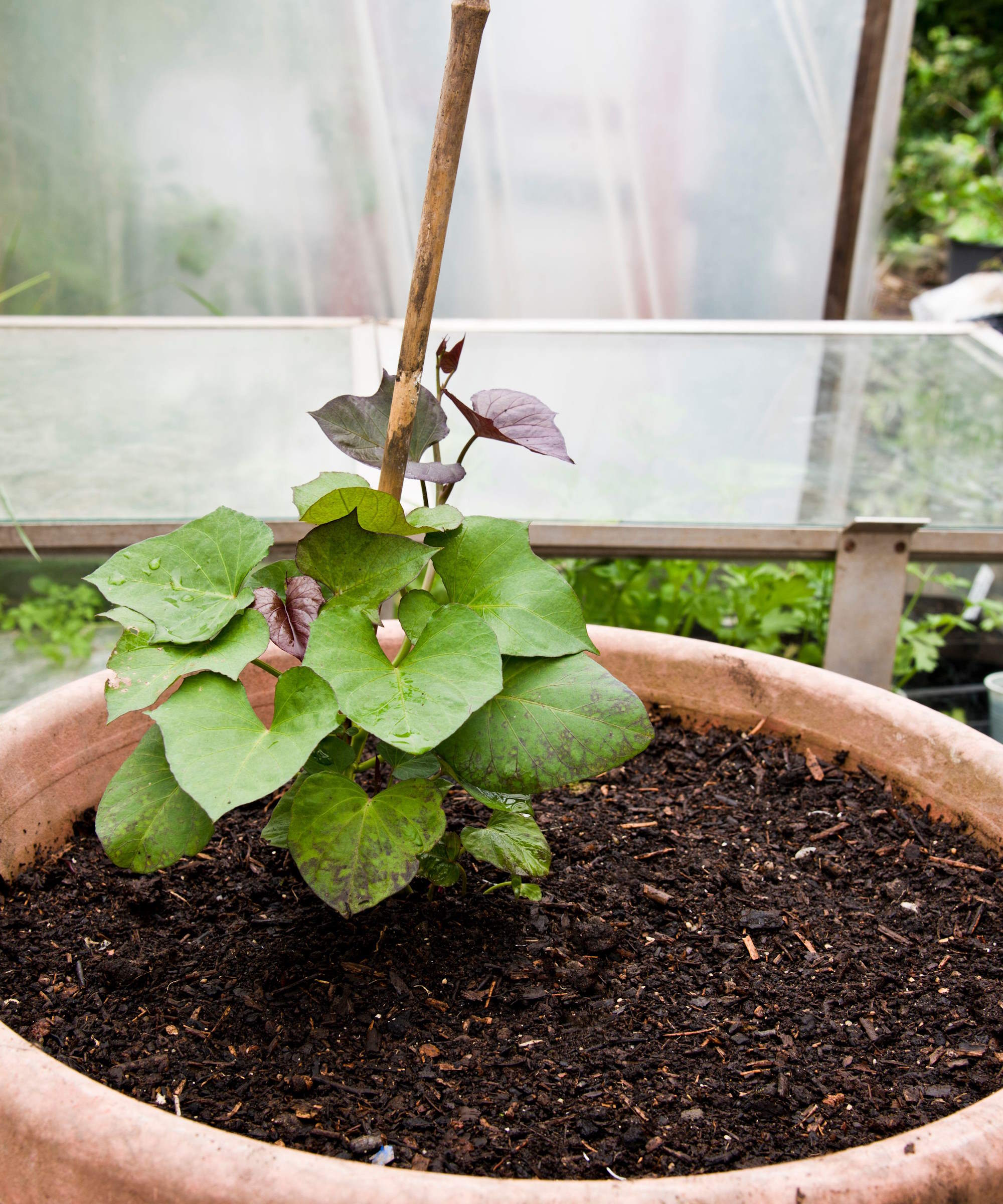
Sweet potatoes like warmth and heat to grow and all risk of frost must be ended for your location before they are planted outdoors. Place the pot in a sunny spot in your backyard, ideally where the plant can get six to eight hours of direct sunlight per day.
5. Water the container regularly
As with any crops growing as part of a container garden, plants will require more watering and feeding than crops planted in the ground. Pay close attention to when to water plants to keep the soil consistently moist, especially when it comes to keeping soil moist in summer when it can dry out quickly.
Check the moisture levels an inch or two below the surface when watering plants in containers using your fingers, or a soil moisture meter, available at Amazon. The soil wants to be moist for optimum growth, but not waterlogged, as this can lead to rot.
6. Have a fertilizing schedule
Just like watering, regular fertilizing is important as it keeps nutrients available in the soil to help the plants develop strongly. Sweet potatoes can use up all the goodness quickly in the container, so replenishing levels regularly is a must.
Christy Wilhelmi advises: ‘Anything growing in containers needs to be fed more often than crops planted in the ground. Roots can't reach deep for minerals and nutrients when in pots, so we have to feed at least monthly to keep the plants going through the growing season. A basic organic vegetable fertilizer will do the trick.’
Either a granular or liquid fertilizer can be used to feed sweet potatoes in containers, with Jon Traunfeld recommending a feed ‘every two weeks if using a liquid fertilizer and monthly if using a dry granular fertilizer’.
7. Harvest tubers carefully
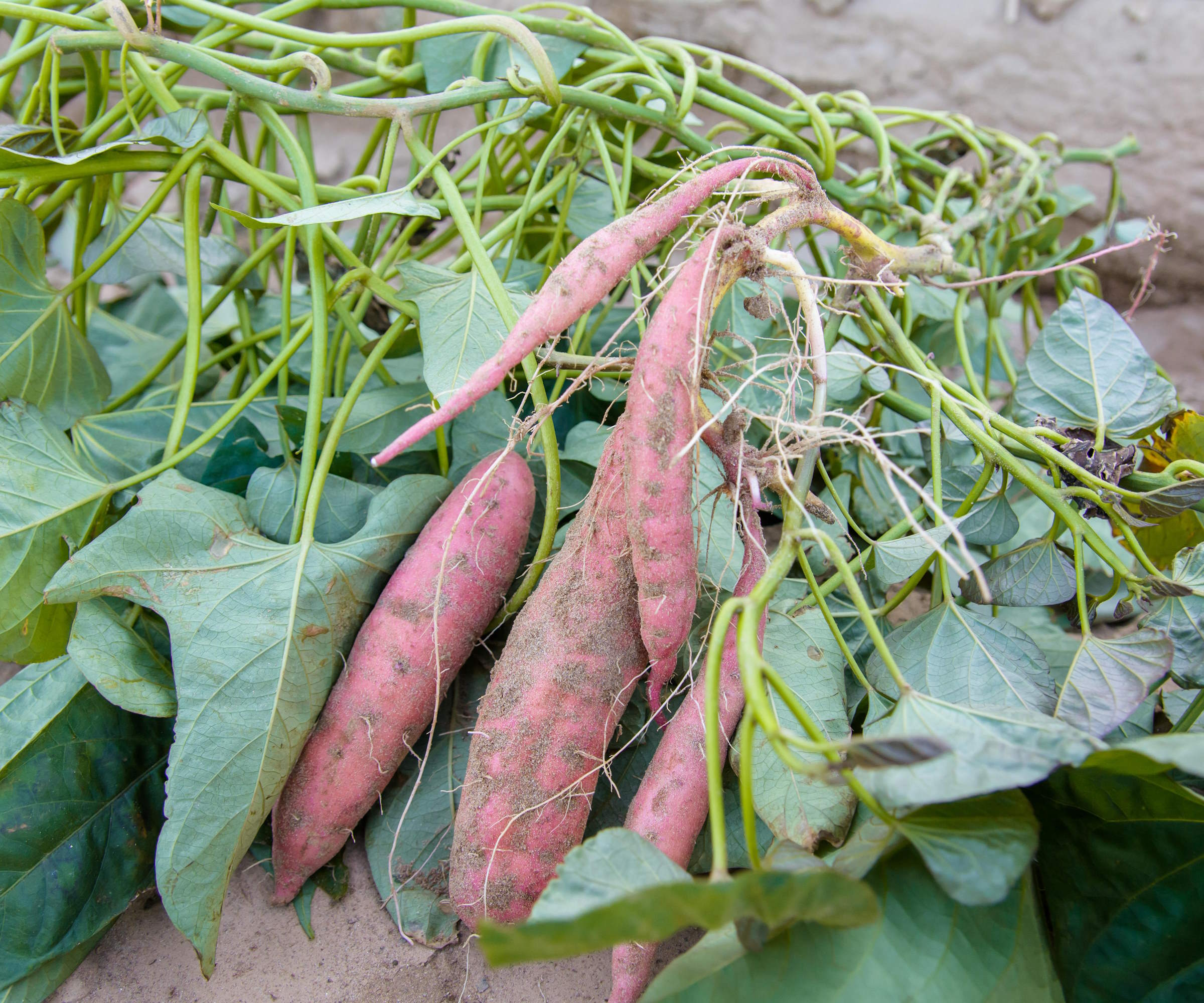
It can take up to five months for sweet potatoes to be ready to harvest. Just like when growing potatoes, the tell-tale sign is when the foliage starts to turn yellow and dies back. This will happen in late summer and fall and, when you harvest sweet potatoes, take care when lifting the tubers to avoid damaging them.
When growing the crop in containers, it can be simpler to harvest as you can tip the contents of the pot out and rummage through the soil for the tubers.
Shop for essentials for growing sweet potatoes in a container
Vardaman is a compact type of sweet potato and is ideal for growing in containers. Named after the famous sweet potato growing town in Mississippi, the tubers have golden skin and deep orange flesh.
A five pound box of all natural fertilizer with 4-4-4 formula to use throughout the growing season on your vegetables.
A pack of 5 heavy-duty 10 gallon grow bags made of thickened nonwoven fabric. The pots are moderately permeable to ensure they do not retain excess water.
FAQs
What size grow bag do I need for sweet potatoes?
Grow bags are a handy, portable, and space-saving method to grow lots of vegetables. Available in various sizes, these inexpensive bags are practical solutions for people growing in urban vegetable gardens. A grow bag of at least 10 gallons will be sufficient for one sweet potato plant.
How deep should a planter box be for sweet potatoes?
Sweet potato plants grow deep roots and need space below the surface to develop good-sized tubers. Any planter should be at least 15 inches deep to guarantee a decent yield.
Sweet potatoes are a delicious and versatile crop, high in fiber and nutrients. While there are many ways to cook your harvested tubers, the fastest way is to cook the sweet potatoes in a microwave. It can take as little as five minutes to get a tasty treat to adorn with your chosen toppings - just ensure to pierce the skin to allow steam to escape from the sweet potato.







